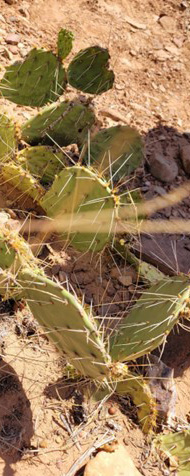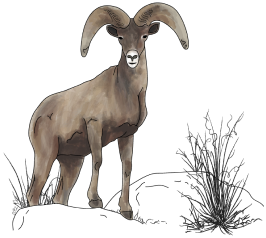Opuntia phaeacantha Engelm.
Eukaryota > Viridiplantae > Streptophyta > Streptophytina > Embryophyta > Tracheophyta > Euphyllophyta > Spermatophyta > Magnoliopsida > Mesangiospermae > eudicotyledons > Gunneridae > Pentapetalae > Caryophyllales > Cactineae > Cactaceae > Opuntia > Opuntia phaeacantha [1]

Image of O. phaeacantha including the entire plant. Image by Kylee Larsen. [6]
Perennial succulent, woody at the base with age, tan to brown spines emerging from obovate to elliptic. The spines turn gray with age. O. phaeacantha contain what are called areoles (the region containing the flowers or spines). The spines are present at most areoles, but sometimes only on the upper quarter of each pad. In the areas where there are spines, there are typically 2-8 per areole, with the largest spines 3-7 cm long. The shape of the spines is usually deflexed, straight or curved, and distinctly wide and flat at the base, and the color brown to red-brown or chalky white. Flowers have numerous petals that are yellow with red near the base. The flowers can also be entirely pink, or red. Flowers are 3-4 cm long with numerous stamens, with filaments that are greenish near the base and pale yellow to white near the top.; style white, topped with a ring of green to yellow-green stigma lobes. Typically, it flowers between April and June. The fruits are fleshy wine-red to purple on the outside, greenish or reddish on the inside. The fruit also contains small spines [2].
![Image of the fruit of O. phaeacantha. Image by Stan Shebs. [7]](/crfs/images/native-plants/plant-directory/pricklypear-sec.jpg)
Image of the fruit of O. phaeacantha. Image by Stan Shebs. [7]
There are a few species that look similar to O. phaeacantha which were actually former varieties of the species. Opuntia engelmannii, a species with which this taxon is known to hybridize, can be distinguished from O. phaeacantha by the usually sprawling, decumbent (reclining on the ground with tip ascending) growth form. The pads turn reddish (or occasionally purplish) after stress and dense glochids at each areole. Another species that it can be confused with is Opuntia macrocentra, which shares the trait of bicolor yellow and red flower petals. O. phaeacantha is distinguished from that species based on spine length. O. macrocentra can often have much longer spines, up to 17 cm long [2].
Opuntia phaecantha has had a challenging taxonomic history that is rife with rearrangements and numerous synonyms. Opuntia phaecantha is known to hybridize with a number of other species, thus creating a series of intermediates that have resulted in a more than 19 subordinate taxa, including 18 described varieties and one subspecies.
![Image of O. phaeacantha including flowers, spines, and stems. Image by Kylee Larsen. [8]](/crfs/images/native-plants/plant-directory/pricklypear-third.jpg)
Image of O. phaeacantha including flowers, spines, and stems. Image by Kylee Larsen. [8]
The fruit is edible and is eaten fresh or dried, made into jams, jellies, juice and wine; pads are also edible and were prepared by roasting, boiling, or pulping and making into cakes; the seeds were ground into flour, although some say that prickly pear seeds are toxic and should not be eaten in quantity [2].
Native Americans used cactus plants, in their original home terrain, intensively. They harvested and ate the fresh fruit and flowers, dried the seeds for oils and ate the young cladodes as vegetables. They made anti-diabetic medicines and laxatives [3, p. 9].
Some species of cochineal insects, which feed on opuntia, convert its juice into a reddish liquid. The Aztecs dried and ground them to make a deep, red dye. This was developed into an export industry under the Spanish in Mexico and was one of Europe s major imports form the Americas [3, p. 9].
![Distribution map of O. phaeacantha on a county level. [9]](/crfs/images/native-plants/plant-directory/pricklypear-fourth.jpg)
Distribution map of O. phaeacantha on a county level. [9]
Opuntia phaeacantha was last assessed for NatureServe 28 Feb 2003 and is considered secure in New Mexico and Arizona, although it has not been assessed across much of its range [5]. It has not been assessed for the IUCN Red List.
O. phaeacantha occurs in Mojave Desert shrub, xeric sagebrush, Colorado Plateau shrub, pinyonjuniper, and mountain brush communities [4, p. 260]. It is found on sandy to rocky soils, below 7,000 ft (2134 m) [2]. O. phaeacantha is considered an epiphyte, which is a plant that grows on other plants.
[1] "Taxonomy Browser (Opuntia phaeacantha)." National Center for Biotechnology Information, http://www.ncbi.nlm.nih.gov/Taxonomy/Browser/wwwtax.cgi?mode=Info&id=176270
[2] Hazelton, A. (Ed.). (2017). Opuntia phaeacantha. SEINet portal network - Opuntia Phaeacantha. Retrieved September 12, 2022, from https://swbiodiversity.org/seinet/taxa/index.php?tid=3384
[3] Beinart, W., &; Wotshela, L. E. (2011). Prickly pear: A social history of a plant in the Eastern Cape. Wits University Press.
[4] Buren, R. V., Cooper, J. G., Shultz, L. M., &; Harper, K. T. (2011). Woody Plants of Utah. Utah State University Press.
[5] "Opuntia phaeacantha, New Mexico Prickly-pear " NatureServe Explorer 2.0, https:// explorer.natureserve.org/Taxon/ELEMENT_GLOBAL.2.146302/Opuntia_phaeacantha
[6] Photo by Kylee Larsen.
[7] Photo by Stan Shebs. https://commons.wikimedia.org/wiki/File:Opuntia_phaeacantha_4.jpg
[8] Photo by Kylee Larsen.
[9] Photo from USDA Plants Database. https://plants.usda.gov/home/plantProfile?symbol=OPPH



